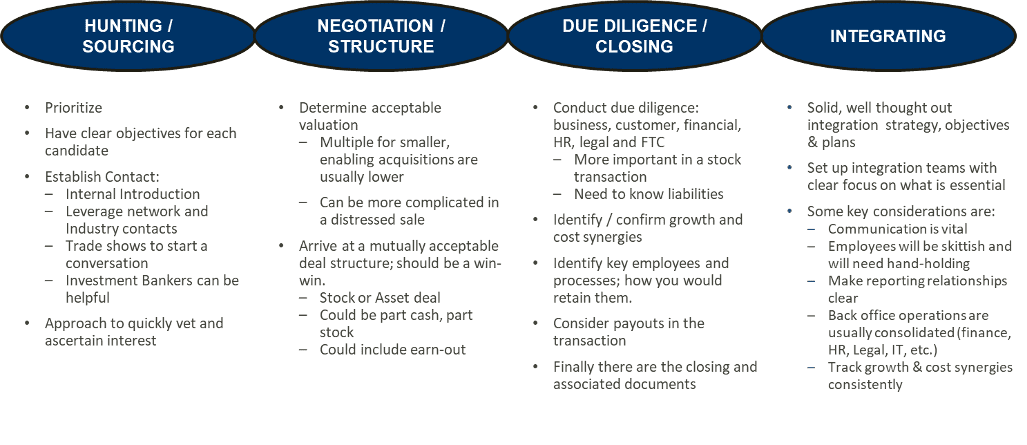The initial negotiation is primarily around deal structure and valuation. Some considerations are that you expect to pay a lower multiple for a smaller player. You should, if possible, prefer an asset transaction as you leave the liabilities behind. Consider part cash, part stock deals – especially if you want the current owners to stay on after the merger. Once there is an agreement with a candidate to proceed further, there should be more detailed due diligence that could include business, customer, financial, and legal research.
In the COVID environment, it is important to pay special attention to the impact on sales, margins, customers, suppliers, employees, what work-from-home might mean in this particular case, or are employees furloughed, and how management handled the changes that have taken place. Law firms with M&A capabilities are available to help in the negotiations, develop the structure, and the closing documents. Remember that many of the companies pursuing M&A are looking for a bargain.
Finally, there is the integration, which is where many companies fail. A well thought out plan with clear objectives is needed. Some key things to remember: integrate what has to be integrated to achieve the objectives. Do not close plants unless you can pick up the manufacturing. The customer interface is critical. If the acquired company’’s core competencies are important, ensure that these are maintained. Both your employees and employees of the acquired company, need to clearly understand the process and expectations. Most companies will set up several integration teams, which can help make the integration more seamless.
Here are some things to consider to increase your probability of success:
- Communication is Vital: Starting with initial announcements through the complete integration process, employees need to know the strategic direction and, more importantly, what it means to them. Confusion and uncertainty leads to inefficiencies and loss of productivity. Communicating with other stakeholders is important as well: consider customers, industry partners, investment community, etc.
- Reporting Relationships. Clarity on reporting relationships is vital. Do this as soon as possible so that people understand the organization structure. For close-in acquisitions there are likely to be many more reporting relationships. For enabling acquisitions reporting may be limited to a few senior executives plus, at a minimum, the finance department, other back office operations, and possibly R&D/Engineering. Interestingly, one of the merger principles at Dow Chemical was that the CFO had to be a Dow person (even if the CEO was not).
- Decision Making Authority. Quickly determining and defining the key executives and integration team leaders with clear decision-making authority helps resolve people issues.
- Project or program structure can be deployed to manage the integration, especially for a larger transaction, with a mix of a small full time integration team and part time representation from the necessary functions. Having dedicated integration resources will help maintain business momentum with separate groups focusing on day-to-day operations.
- Key Employees & Retention Plans: It is important to identify key employees, even pre-closing, and evaluate if retention plans are needed. Competitors will go after these people or they can be out looking for jobs during the uncertainty
- Finance: A key priority is always cash management and processes for financial closings where systems can be an issue. You can use short term solutions such as downloading financial information, then building a bridge. No matter what you do, think about this ahead of time and have a plan in place.
- HR: Non-US acquisitions can be more straightforward because you can leave policies and procedures in place. In the US, you must consider the differences in benefits and processes. There may be a cost associated and transitions can be complicated.
- Legal: Laws differ from country to county and all outstanding legal issues must be identified with a plan on how to deal with these.
- Tracking Growth and Cost Synergies is essential to get the full value creation benefits. Focus on four to five areas that represent the greatest opportunities with clear, quantifiable goals and assigned responsibilities. As you learn more, open the aperture beyond traditional synergies to identify other value creation opportunities.













Recent Comments